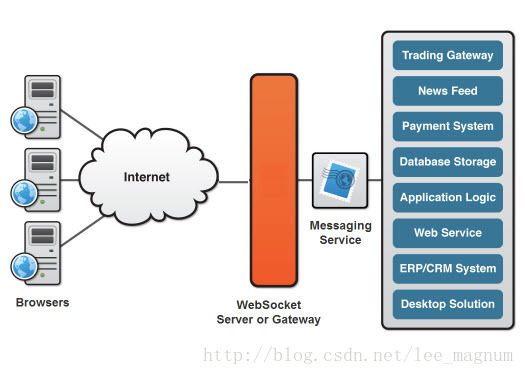Introduction to WebSockets in HTML5 Practice and Analysis
The HTML5 WebSockets specification defines an API that allows web pages to communicate with remote hosts in two directions using the WebSockets protocol. Introduces the WebSocket interface and defines a full-duplex communication channel over a socket on the network. HTML5 WebSockets offer a huge reduction in unnecessary network traffic and latency without scaling the polling and long polling solutions that are used to simulate a full-duplex connection by maintaining two connections.
HTML5 WebSockets accounts for network hazards such as proxies and firewalls, enabling streaming over any connection, and being able to support upstream and downstream communications on a single connection, HTML5 WebSockets-based application servers reduce the burden on existing The machine supports more concurrent connections. The figure below shows a basic WebSocket-based structure, in which the browser uses a full-duplex WebSocket connection to communicate directly with the remote host.

Applications typically use long polling for basic line defense firewalls and proxies. The technique is effective, but is not suitable for applications with sub-500ms latency or high throughput needs. Plug-in-based technologies, such as Adobe Flash, also offer some level of socket support, but have been saddled with proxy and firewall traversal issues that WebSockets now solve.
WebSocket detects the presence of a proxy server and automatically sets up a tunnel through the proxy. The tunnel is established by issuing an HTTP CONNECT statement to the proxy server, which requests the proxy server to open a TCP/IP connection to a specific host and port. Once the tunnel is established, communication can flow through the proxy. Since HTTP/S works in a similar way, secure WebSockets over SSL can leverage the same HTTP connection technology. Note that WebSockets are only starting to be supported by modern browsers (Chrome now supports WebSockets natively). However, backward-compatible implementations enable today's browsers to take advantage of this emerging technology.
WebSockets-like other parts of HTML5 work such as local storage and Geolocation-was originally part of the HTML 5 specification, but was moved to a separate standards document within the specification set. WebSockets has been submitted to the Internet Engineering Task Force (IETF) creators, the Web Hypertext Applications Technology Working Group (WHATWG). Authors, evangelists and companies involved in standardization still refer to the original feature set, including WebSockets, "HTML5." For more related content, please pay attention to the PHP Chinese website (www.php.cn)!

Hot AI Tools

Undresser.AI Undress
AI-powered app for creating realistic nude photos

AI Clothes Remover
Online AI tool for removing clothes from photos.

Undress AI Tool
Undress images for free

Clothoff.io
AI clothes remover

AI Hentai Generator
Generate AI Hentai for free.

Hot Article

Hot Tools

Notepad++7.3.1
Easy-to-use and free code editor

SublimeText3 Chinese version
Chinese version, very easy to use

Zend Studio 13.0.1
Powerful PHP integrated development environment

Dreamweaver CS6
Visual web development tools

SublimeText3 Mac version
God-level code editing software (SublimeText3)

Hot Topics
 1386
1386
 52
52
 Table Border in HTML
Sep 04, 2024 pm 04:49 PM
Table Border in HTML
Sep 04, 2024 pm 04:49 PM
Guide to Table Border in HTML. Here we discuss multiple ways for defining table-border with examples of the Table Border in HTML.
 HTML margin-left
Sep 04, 2024 pm 04:48 PM
HTML margin-left
Sep 04, 2024 pm 04:48 PM
Guide to HTML margin-left. Here we discuss a brief overview on HTML margin-left and its Examples along with its Code Implementation.
 Nested Table in HTML
Sep 04, 2024 pm 04:49 PM
Nested Table in HTML
Sep 04, 2024 pm 04:49 PM
This is a guide to Nested Table in HTML. Here we discuss how to create a table within the table along with the respective examples.
 HTML Table Layout
Sep 04, 2024 pm 04:54 PM
HTML Table Layout
Sep 04, 2024 pm 04:54 PM
Guide to HTML Table Layout. Here we discuss the Values of HTML Table Layout along with the examples and outputs n detail.
 HTML Input Placeholder
Sep 04, 2024 pm 04:54 PM
HTML Input Placeholder
Sep 04, 2024 pm 04:54 PM
Guide to HTML Input Placeholder. Here we discuss the Examples of HTML Input Placeholder along with the codes and outputs.
 HTML Ordered List
Sep 04, 2024 pm 04:43 PM
HTML Ordered List
Sep 04, 2024 pm 04:43 PM
Guide to the HTML Ordered List. Here we also discuss introduction of HTML Ordered list and types along with their example respectively
 Moving Text in HTML
Sep 04, 2024 pm 04:45 PM
Moving Text in HTML
Sep 04, 2024 pm 04:45 PM
Guide to Moving Text in HTML. Here we discuss an introduction, how marquee tag work with syntax and examples to implement.
 HTML onclick Button
Sep 04, 2024 pm 04:49 PM
HTML onclick Button
Sep 04, 2024 pm 04:49 PM
Guide to HTML onclick Button. Here we discuss their introduction, working, examples and onclick Event in various events respectively.




